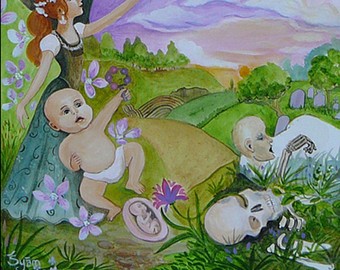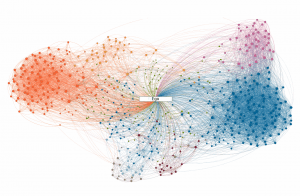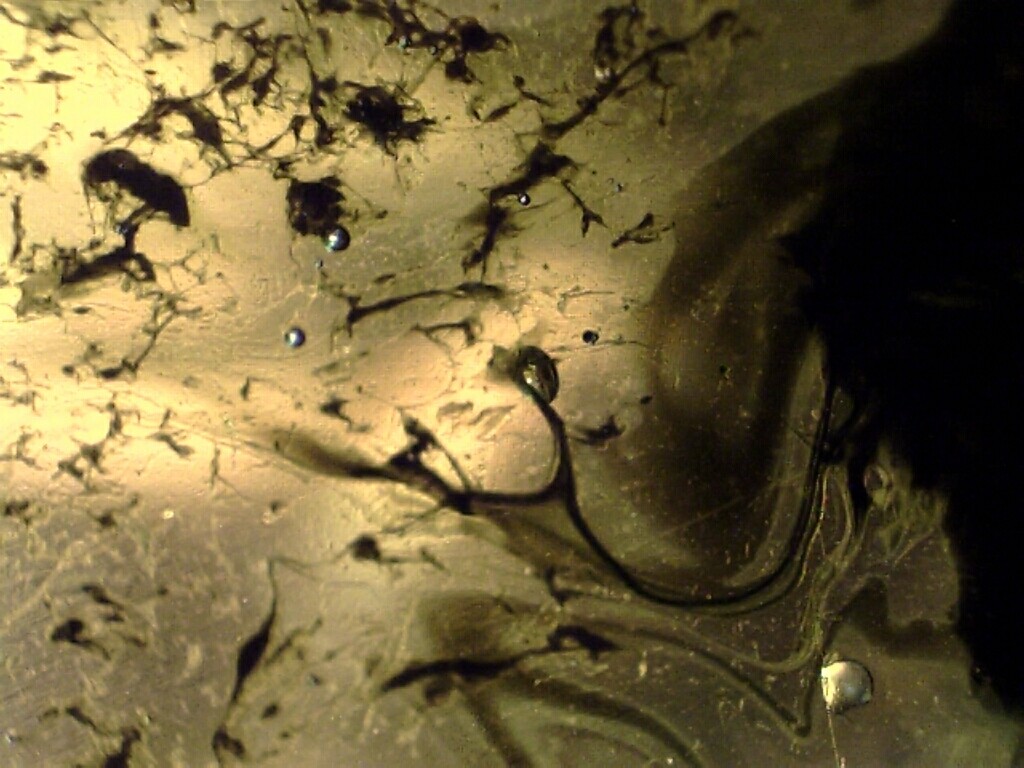
Dedicated to the memory of our beloved neighbor H. Ghanam, whose news of passing away reached me just few hours after I finished writing this text in Trivandrum – Kerela.
The conditioned and
Name-and-form,
All are flowers in the sky.
Nameless and formless,
I leave birth-and-death.
Layman P’ang
Life and the Eternal Twins – Birth and Death
The Four Encounters

In our mountain villages, a morning can rarely pass without the ‘village microphone’ announcing loudly the news about a death and a funeral. My grandfather always asks us to be silent while the announcement is done. He listens carefully then he walks to his room to write down the date and the name of the departed then he gets himself ready to go to the funeral regardless whether he personally knows the departed or not. If not, he would for sure know many of his relative… Death in these villages is a daily news.
Birth is so much the same, but may be less ceremonious. Whenever a women gives birth in the village many acquaintances come to visit, but mainly only women. In the village’s traditional society birth is women’s business, while death is that of men.
My first remembered encounter with death was when my paternal grandfather passed away. I was still 5 years old. I don’t remember that I did feel any grieve. I just missed seeing him seated in the corner of the big courtyard in front of the kitchen door. He was “old” in my small mind. May be I thought it was normal for the old to die. At least this is how grownups explained. I’m sure (though I do not remember) that my mother told me he must already been born somewhere and a loving family is now so happy to care of the baby boy… the belief in reincarnation is one of the most soothing beliefs in that mountain area.
The second remembered encounter was not a personal one… I was already in the 6th year of school when one of the teachers was absent for a while because her father passed away. I clearly remember my contemplation over loss. I remember how I drew in my mind the picture of a house where the favorite seat of that father became forever empty. I remember imagining how the life of these people will be like and how things will change, how they will forget and once more be back to their everyday life concerns… At that age death for me was an astonishing event.
The third well remembered encounter was in 2003, when I received the news of my spiritual teacher’s departure. I was abroad in medical school and it was a sunny spring day of the Volga steppe. I remember that day well, I remember the feeling of loss. I remember it clearly because it was a mixture of sweat and bitter… Dr. M. Basha was a master of several disciplines: history, linguistics and spirituality. He was a real teacher and a real scholar. But spirituality was his highest dedication. The subject of life and death was the core of his teachings. Being his disciple (as I still consider myself) I understood perfectly what death is… I had a peaceful feeling about his passing away because I knew he was well prepared for departure but the unpleasant feeling was because I remembered his words in our last meeting: “This kind of medicine is not for you. It is so gross and partial. You are not here to do this duty. Your duty is subtle. It is teaching, writing… your tool is the pen not the scalpel.”At that time I was enjoying learning medicine and planning my steps as a doctor… it was uneasy to have both the words of my teacher and my interest in medicine contradicting one another. I had to wait some more years before the clear vision would arise. Now, when I remember Dr. Basha more than 10 years after his departure, I understand his words very well and can see clearly that there was no contradiction at all… I find that Life led me to the place he predicted. And if I would practice medicine at any time in the future I know it will be the holistic way, the subtle way… the one that leads to the experience of deeper consciousness.
The fourth encounter with death is the most clear. The day I was leaving to India to stay in an ashram for a while, when I received the news of my closest cousin having a terrible accident after which he immediately died. He was only around 36 years old and was full of energy and enthusiasm. I could an only remember his smiling face shining with hope and joy. I may had never seen him frowning… He was young and his death was so unexpected. His death did not follow the rule of “the death of the old is normal”. It was the total opposite of the passing away of our mutual grandfather.
My stay in the ashram that time was a period of intensive meditation. On the deepest levels of awareness all my life with all its experiences and memories, with all its connections and ties, all beliefs and all the ‘known’ appeared to be not more real than a dream. Whatever thing or person I could think of, no matter how close, be it my parents, be it my house, was as real as a myth, as real as sheer imagination. The only real thing was the now. Everything outside it could not survive. Looking back to the memories of those who I could remember, dead or alive, was only full with gratitude.
My fourth encounter with death was that of understanding. It was mature. There were no questions to ask, no answers to expect!
Friends with the Twins
During my years in medical school I had to encounter many dead bodies in the anatomy classes and at the morgue of forensic medicine department. I have seen many patients passing away in CCUs and ICUs. I have met many end stage disease patients for whom our professor would predict a life span of few more days… and I have always wandered: Death has always been there, even prior to any human mind.
Why then it is still a shocking event? Why isn’t death accepted as any other phenomenon? And would man ever accept it?
In all countries and traditions equally birth is celebrated and death is mourned and the span between the two is called life. In that span between the two one is received with joy while the other is even dreaded to be spoken about.

With deeper understanding Life is wider than birth and death. When the wave rises on the surface of the ocean and when the wave falls, why do we insist to see the wave not the ocean? The two opposites are contained in the big ocean of Life as light and darkness are neighbor one another on the surface of the same moon. Life and death are the eternal friends each, of which prepares the splendor of the other. How childish of us is to reject one and embrace the other!
By accepting this unity of death and birth, accepting Life in its wider sense we are nearer to make peace with death. When we realize that death is just another aspect of Life we are then ready to look into our fear and question it, ready to follow the pain of loss to its very origin and heal it deep there from the roots.
Deep in the Roots

Each of us has a self-drawn image/map of oneself that contains our identification and the network of connections between them: name, family, friends, status, home, nationality, beliefs, etc… We tend to think of ourselves in terms of this map and relate to everything around according to the relations drawn in this map. We expect the whole universe to respect that image and to treat us and our surrounding according to it. This image/map is our most comfortable design for the world around us, it represents the world as we see it. The relationships within the map are established from the view point of the small self (the ego) under the impact of habit and time and we do live our day to day life assuming the map is true and eternal. Living with such an assumption allows anything that disturbs the positions of people and things inside the map to shakes our whole world starting from our own self. This makes us prone to pain and suffering.
We are attached to our close and beloved ones, they form a part of the image we have of ourselves, and that’s why their loss creates a feeling that we are losing a part of our own self, our identity. Dwelling emotionally on the memories (sweet and bitter) feeds the old map despite the change that took place in reality. Here the conflict starts between what is and our imagined alternative. Suffering starts.
We never feel the pain for the departed themselves. The pain is that of the egoistic self that feels the loss. Suffering is there for not having our cozy bubble respected by circumstances and not having our wishes, which oppose what is,fulfilled. We cannot feel pain for the departed even if their death was tragic simply because after passing away they cannot be in pain. We suffer because we are losing the comfort of the known, the long lived with image. Pain arises sometimes from a silent feeling of guilt or regret, but this is once more a form resistance to what is, to the present.
The mind has no way to peep into the future or rest in the present. The mind can only dwell in the past and project it on the present and the future. With the death of close ones the mind cannot play its game again. It will find some elements missing. The past can no more be easily projected. It is a great disappointment. It is painful! For some time one can be totally mind-less. What is usually called a shock is a moment of awakening. The mind is perplexed and you are out of its control.
Usually people soon “recover”.One gets used to the loss and a new map of identifications will soon be drawn only to be shaken with another loss after some time. The same pattern of projection and pains repeated.
When the loss disturbs the map of identifications the chance is great to stay beyond the loops of mind, to anchor oneself to the now with deep acceptance and gratitude. The chance is always there to realize the illusion of the self-drawn image, to loosen attachment and false identification. When you encounter death a bell of mindfulness rings! Don’t let it ring in vain!
The Living Dead Body
In certain spiritual traditions adepts are assigned to meditate on the image of a corpse in the cemetery. They are advised to contemplate on the physical changes that take place after death: the color, the smell, the decomposition, the worms up till the point when nothing has remained and the primary element (earth, water, fire, air and ether) that had been borrowed to form the body are all returned back to the vast universe.
In yoga practice, the most common relaxation pose is savasana – the corpse pose. Many people prefer to use the Sanskrit name avoiding correlations with death. Many people would get horrified to imagine the yoga hall full of dead bodies and their own body being one of them. A good yoga teacher would make sure his students really understand the meaning of the word and can really let go of their connection with the physical body as they relax in corpse pose.
Such practices are essential to make peace with death and recognize it as a part of Life. They may not make a personal loss more bearable, but they definitely make death more acceptable.
From an objective point of view death can be totally different. What we perceive to be a dead body is not at all void of life. As a corpse decays it is a home for thousands of tiny living beings feeding on what used to be someone’s body. If you take a closer look you would see these beings that seem to come from nowhere pulsating like a volcanic flow. This pulse of life is sometimes so strong that you may have the illusion that the corpse itself is moving. In our conventional understanding this level of life is of no value. We call it decay because we fail to appreciate it.
When we look at putrid water or a rotten fruit we naturally get disgusted. This aversion is instinctual. It is simply a survival guide that is built in to prevent us from drinking polluted water and eating spoiled foods that may harm us and cause us diseases. But being unsuitable for human heath it doesn’t make this water or fruit void of life.

Scientists assure that the primordial soup from which all life on earth started was an ocean of filthy water with a lot of bacteria-like organisms. It is there where we see the ugly face of death that Life is was preparing for great birth. It is there where we see decay that Life is in its great metamorphosis, preparing for another cycle. It is only through decay that elements can return to earth and make it fertile.
That which seems to be life for us and death for the creatures that live on decay is indeed a preparation for their big feast. And that which is life for them and death for